airbag DODGE GRAND CARAVAN 2009 5.G Owners Manual
[x] Cancel search | Manufacturer: DODGE, Model Year: 2009, Model line: GRAND CARAVAN, Model: DODGE GRAND CARAVAN 2009 5.GPages: 535, PDF Size: 18.61 MB
Page 12 of 535
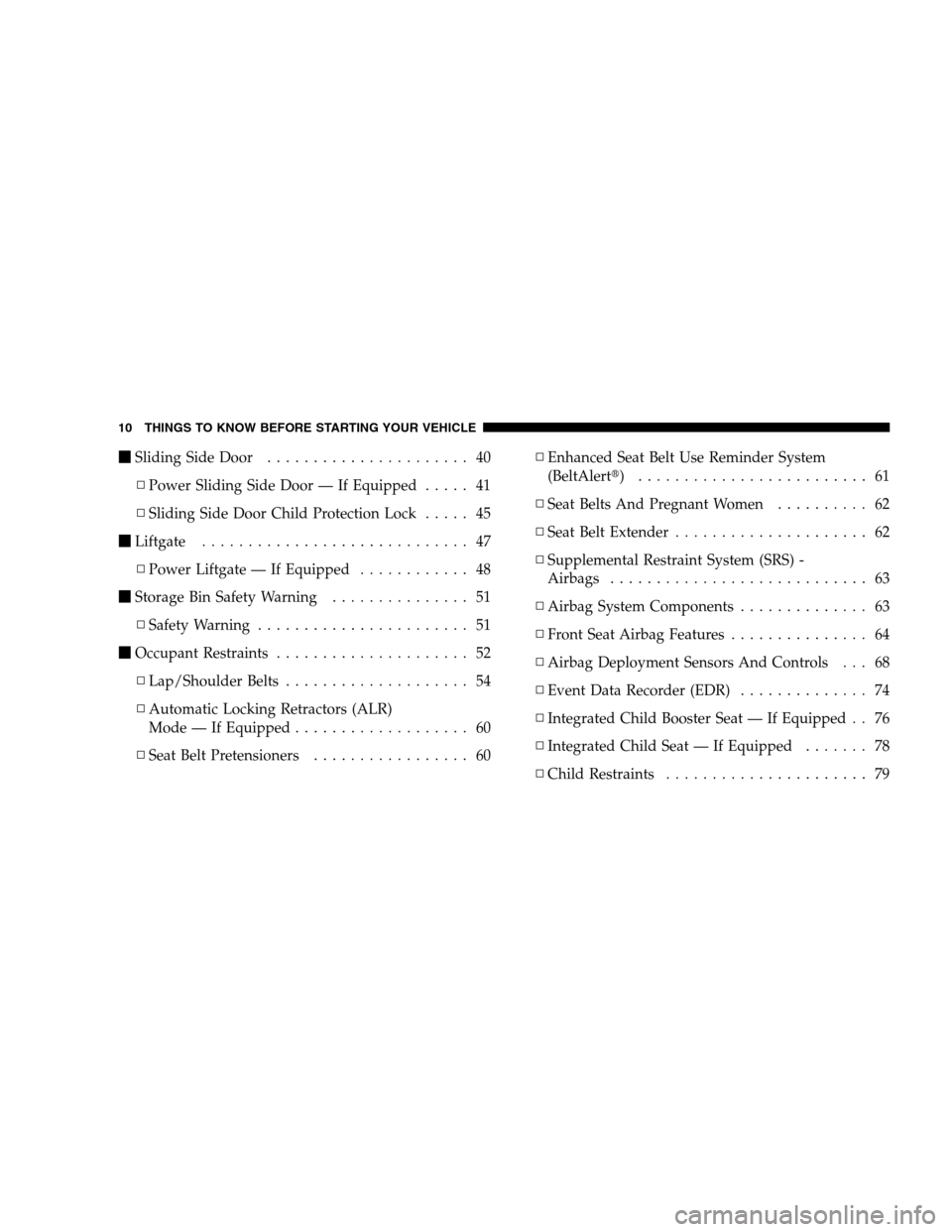
mSliding Side Door . . . . . . . . . . . . . . . . . . . . . . 40
▫ Power Sliding Side Door — If Equipped . . . . . 41
▫ Sliding Side Door Child Protection Lock . . . . . 45
m Liftgate . . . . . . . . . . . . . . . . . . . . . . . . . . . . . 47
▫ Power Liftgate — If Equipped . . . . . . . . . . . . 48
m Storage Bin Safety Warning . . . . . . . . . . . . . . . 51
▫ Safety Warning . . . . . . . . . . . . . . . . . . . . . . . 51
m Occupant Restraints . . . . . . . . . . . . . . . . . . . . . 52
▫ Lap/Shoulder Belts . . . . . . . . . . . . . . . . . . . . 54
▫ Automatic Locking Retractors (ALR)
Mode — If Equipped . . . . . . . . . . . . . . . . . . . 60
▫ Seat Belt Pretensioners . . . . . . . . . . . . . . . . . 60 ▫
Enhanced Seat Belt Use Reminder System
(BeltAlertt) . . . . . . . . . . . . . . . . . . . . . . . . . 61
▫ Seat Belts And Pregnant Women . . . . . . . . . . 62
▫ Seat Belt Extender . . . . . . . . . . . . . . . . . . . . . 62
▫ Supplemental Restraint System (SRS) -
Airbags . . . . . . . . . . . . . . . . . . . . . . . . . . . . 63
▫ Airbag System Components . . . . . . . . . . . . . . 63
▫ Front Seat Airbag Features . . . . . . . . . . . . . . . 64
▫ Airbag Deployment Sensors And Controls . . . 68
▫ Event Data Recorder (EDR) . . . . . . . . . . . . . . 74
▫ Integrated Child Booster Seat — If Equipped . . 76
▫ Integrated Child Seat — If Equipped . . . . . . . 78
▫ Child Restraints . . . . . . . . . . . . . . . . . . . . . . 79
10 THINGS TO KNOW BEFORE STARTING YOUR VEHICLE
Page 54 of 535
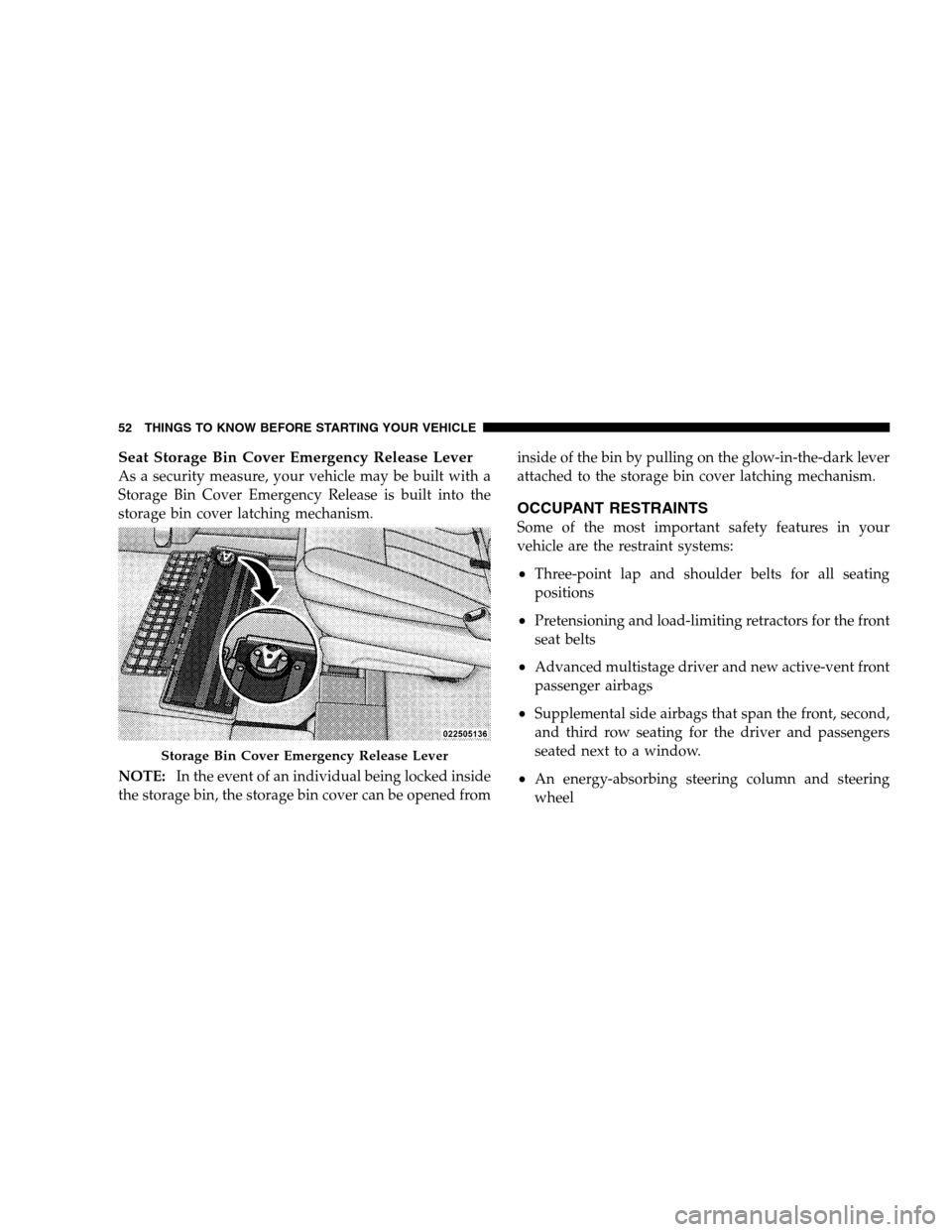
Seat Storage Bin Cover Emergency Release LeverAs a security measure, your vehicle may be built with a
Storage Bin Cover Emergency Release is built into the
storage bin cover latching mechanism.
NOTE:
In the event of an individual being locked inside
the storage bin, the storage bin cover can be opened from inside of the bin by pulling on the glow-in-the-dark lever
attached to the storage bin cover latching mechanism.
OCCUPANT RESTRAINTS
Some of the most important safety features in your
vehicle are the restraint systems:
Three-point lap and shoulder belts for all seating
positions
Pretensioning and load-limiting retractors for the front
seat belts
Advanced multistage driver and new active-vent front
passenger airbags
Supplemental side airbags that span the front, second,
and third row seating for the driver and passengers
seated next to a window.
An energy-absorbing steering column and steering
wheelStorage Bin Cover Emergency Release Lever
52 THINGS
TO KNOW BEFORE STARTING YOUR VEHICLE
Page 55 of 535
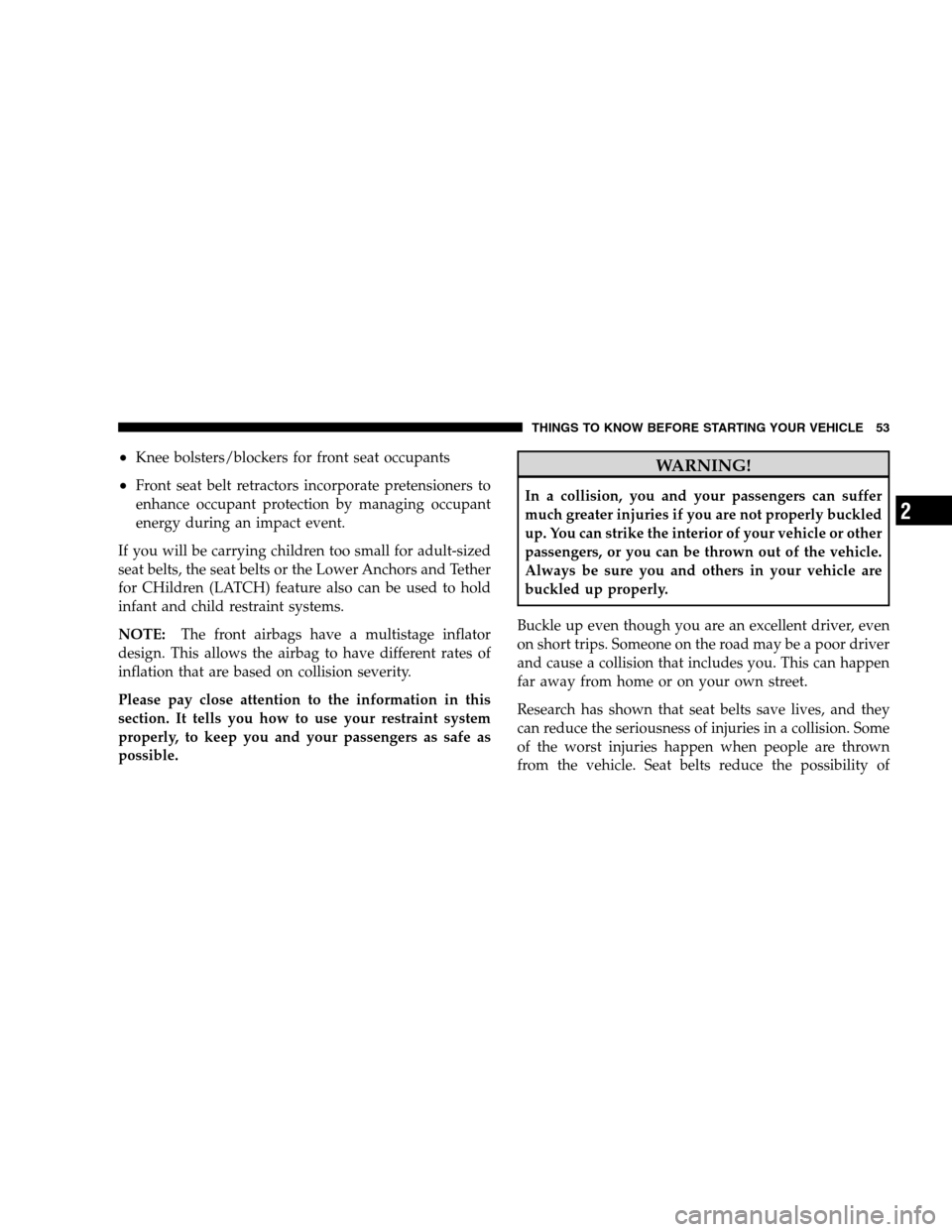
Knee bolsters/blockers for front seat occupants
Front seat belt retractors incorporate pretensioners to
enhance occupant protection by managing occupant
energy during an impact event.
If you will be carrying children too small for adult-sized
seat belts, the seat belts or the Lower Anchors and Tether
for CHildren (LATCH) feature also can be used to hold
infant and child restraint systems.
NOTE: The front airbags have a multistage inflator
design. This allows the airbag to have different rates of
inflation that are based on collision severity.
Please pay close attention to the information in this
section. It tells you how to use your restraint system
properly, to keep you and your passengers as safe as
possible. WARNING!In a collision, you and your passengers can suffer
much greater injuries if you are not properly buckled
up. You can strike the interior of your vehicle or other
passengers, or you can be thrown out of the vehicle.
Always be sure you and others in your vehicle are
buckled up properly.
Buckle up even though you are an excellent driver, even
on short trips. Someone on the road may be a poor driver
and cause a collision that includes you. This can happen
far away from home or on your own street.
Research has shown that seat belts save lives, and they
can reduce the seriousness of injuries in a collision. Some
of the worst injuries happen when people are thrown
from the vehicle. Seat belts reduce the possibility of
THINGS TO KNOW BEFORE STARTING YOUR VEHICLE 53 2
Page 63 of 535
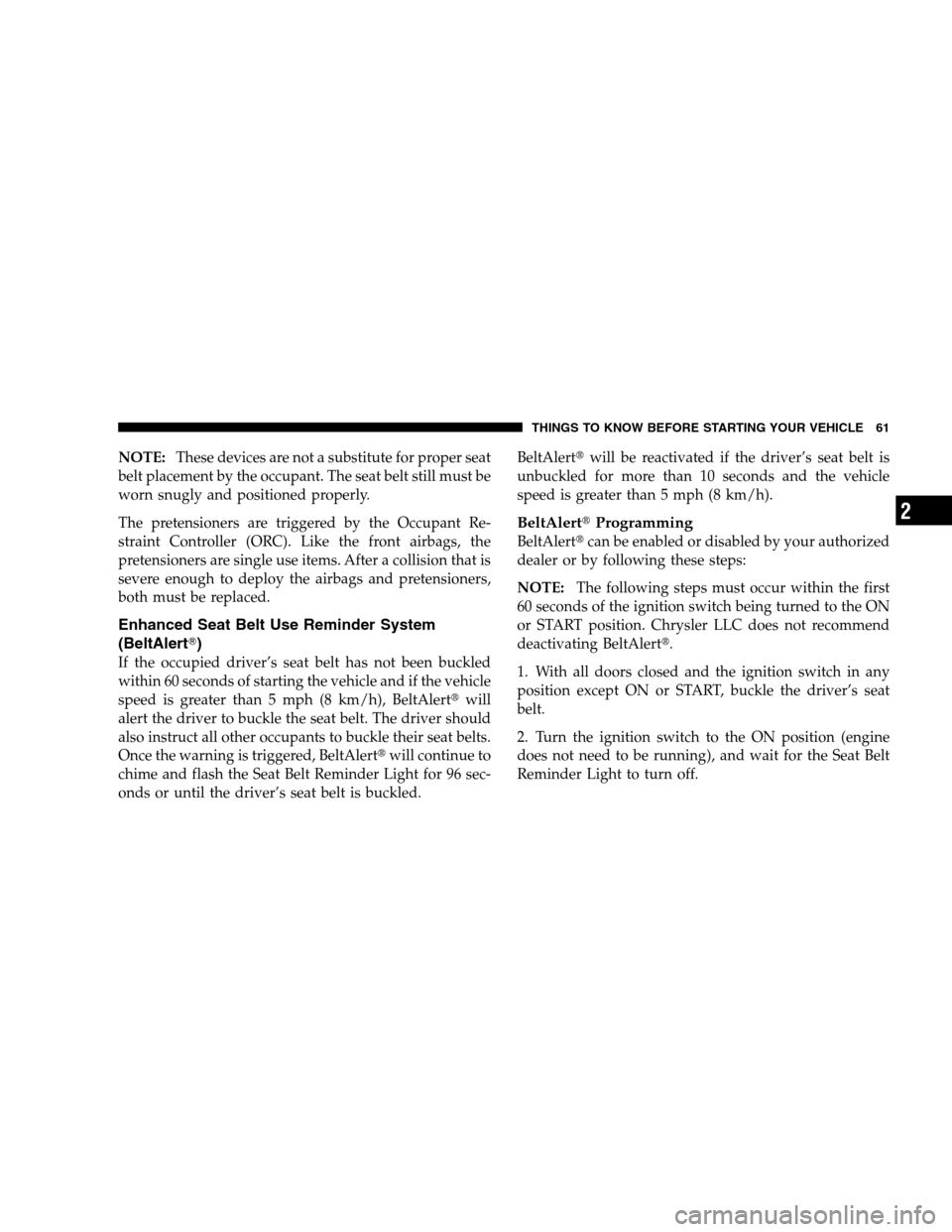
NOTE:These devices are not a substitute for proper seat
belt placement by the occupant. The seat belt still must be
worn snugly and positioned properly.
The pretensioners are triggered by the Occupant Re-
straint Controller (ORC). Like the front airbags, the
pretensioners are single use items. After a collision that is
severe enough to deploy the airbags and pretensioners,
both must be replaced.
Enhanced Seat Belt Use Reminder System
(BeltAlertT)
If the occupied driver’s seat belt has not been buckled
within 60 seconds of starting the vehicle and if the vehicle
speed is greater than 5 mph (8 km/h), BeltAlertt will
alert the driver to buckle the seat belt. The driver should
also instruct all other occupants to buckle their seat belts.
Once the warning is triggered, BeltAlertt will continue to
chime and flash the Seat Belt Reminder Light for 96 sec-
onds or until the driver’s seat belt is buckled. BeltAlertt
will be reactivated if the driver’s seat belt is
unbuckled for more than 10 seconds and the vehicle
speed is greater than 5 mph (8 km/h).
BeltAlertt Programming
BeltAlerttcan be enabled or disabled by your authorized
dealer or by following these steps:
NOTE: The following steps must occur within the first
60 seconds of the ignition switch being turned to the ON
or START position. Chrysler LLC does not recommend
deactivating BeltAlertt.
1. With all doors closed and the ignition switch in any
position except ON or START, buckle the driver’s seat
belt.
2. Turn the ignition switch to the ON position (engine
does not need to be running), and wait for the Seat Belt
Reminder Light to turn off.
THINGS TO KNOW BEFORE STARTING YOUR VEHICLE 61 2
Page 65 of 535
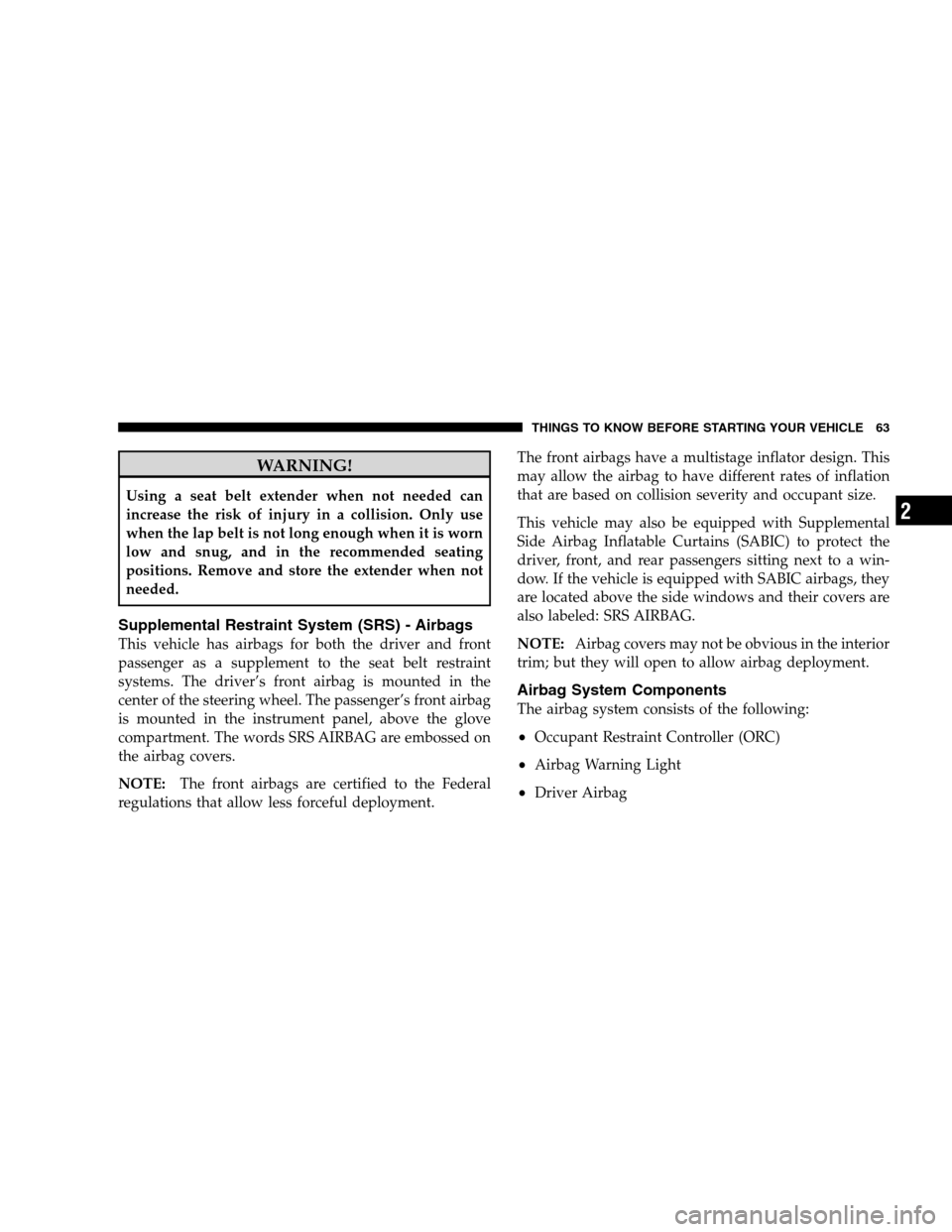
WARNING!Using a seat belt extender when not needed can
increase the risk of injury in a collision. Only use
when the lap belt is not long enough when it is worn
low and snug, and in the recommended seating
positions. Remove and store the extender when not
needed.
Supplemental Restraint System (SRS) - Airbags
This vehicle has airbags for both the driver and front
passenger as a supplement to the seat belt restraint
systems. The driver’s front airbag is mounted in the
center of the steering wheel. The passenger’s front airbag
is mounted in the instrument panel, above the glove
compartment. The words SRS AIRBAG are embossed on
the airbag covers.
NOTE:
The front airbags are certified to the Federal
regulations that allow less forceful deployment. The front airbags have a multistage inflator design. This
may allow the airbag to have different rates of inflation
that are based on collision severity and occupant size.
This vehicle may also be equipped with Supplemental
Side Airbag Inflatable Curtains (SABIC) to protect the
driver, front, and rear passengers sitting next to a win-
dow. If the vehicle is equipped with SABIC airbags, they
are located above the side windows and their covers are
also labeled: SRS AIRBAG.
NOTE:
Airbag covers may not be obvious in the interior
trim; but they will open to allow airbag deployment.
Airbag System Components
The airbag system consists of the following:
Occupant Restraint Controller (ORC)
Airbag Warning Light
Driver Airbag
THINGS TO KNOW BEFORE STARTING YOUR VEHICLE 63 2
Page 66 of 535
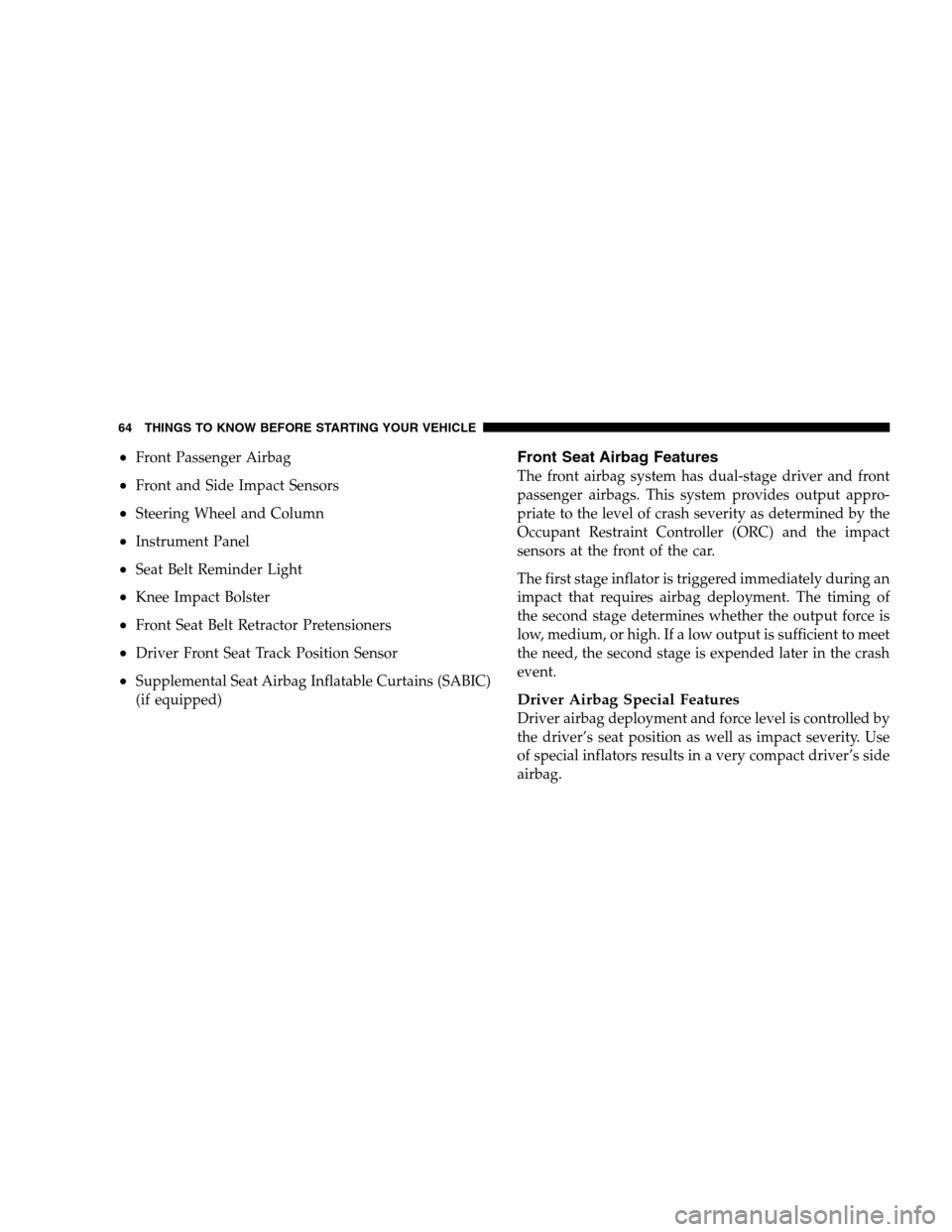
Front Passenger Airbag
Front and Side Impact Sensors
Steering Wheel and Column
Instrument Panel
Seat Belt Reminder Light
Knee Impact Bolster
Front Seat Belt Retractor Pretensioners
Driver Front Seat Track Position Sensor
Supplemental Seat Airbag Inflatable Curtains (SABIC)
(if equipped)
Front Seat Airbag Features
The front airbag system has dual-stage driver and front
passenger airbags. This system provides output appro-
priate to the level of crash severity as determined by the
Occupant Restraint Controller (ORC) and the impact
sensors at the front of the car.
The first stage inflator is triggered immediately during an
impact that requires airbag deployment. The timing of
the second stage determines whether the output force is
low, medium, or high. If a low output is sufficient to meet
the need, the second stage is expended later in the crash
event.
Driver Airbag Special Features
Driver airbag deployment and force level is controlled by
the driver’s seat position as well as impact severity. Use
of special inflators results in a very compact driver’s side
airbag.
64 THINGS TO KNOW BEFORE STARTING YOUR VEHICLE
Page 67 of 535
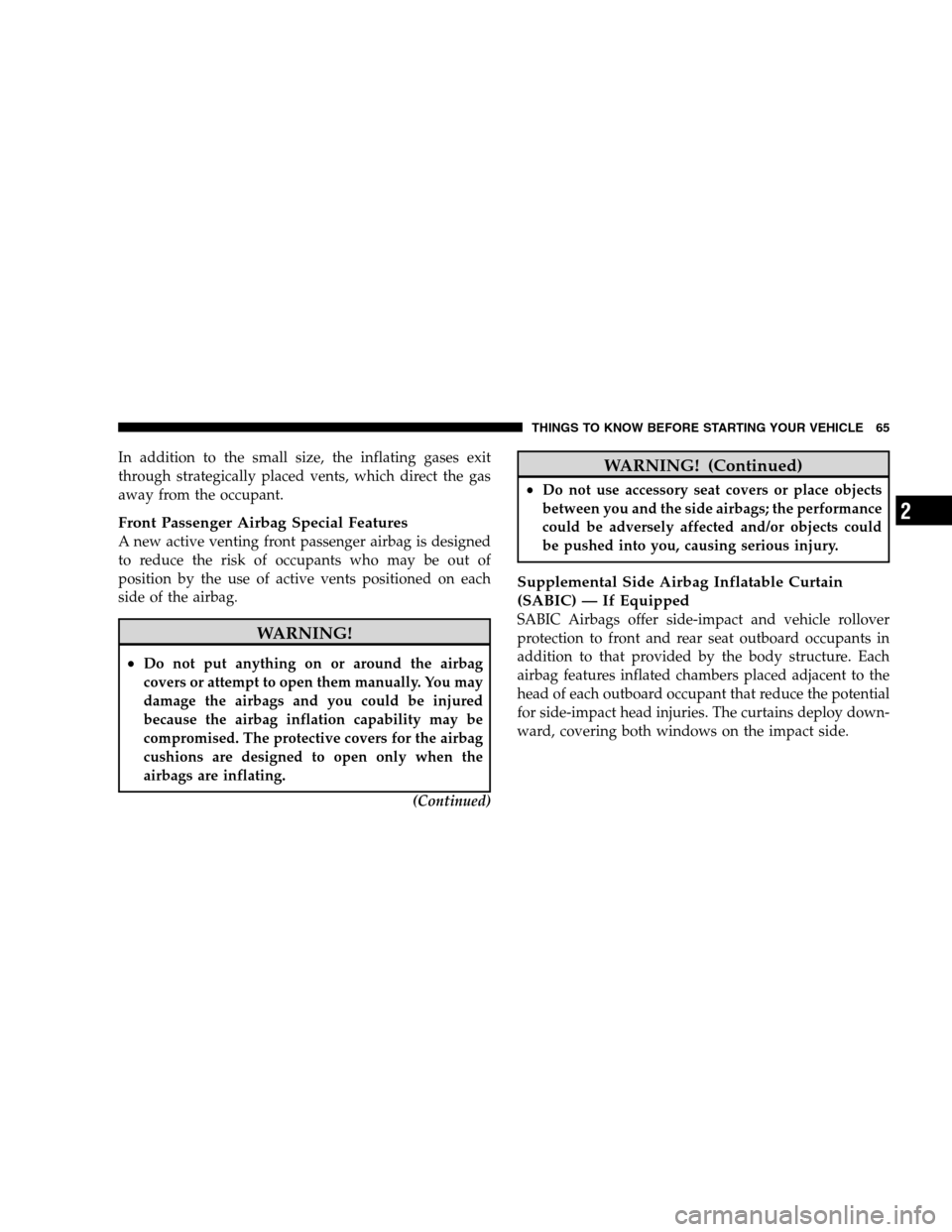
In addition to the small size, the inflating gases exit
through strategically placed vents, which direct the gas
away from the occupant.
Front Passenger Airbag Special Features
A new active venting front passenger airbag is designed
to reduce the risk of occupants who may be out of
position by the use of active vents positioned on each
side of the airbag.WARNING!
Do not put anything on or around the airbag
covers or attempt to open them manually. You may
damage the airbags and you could be injured
because the airbag inflation capability may be
compromised. The protective covers for the airbag
cushions are designed to open only when the
airbags are inflating.
(Continued) WARNING! (Continued)
Do not use accessory seat covers or place objects
between you and the side airbags; the performance
could be adversely affected and/or objects could
be pushed into you, causing serious injury.
Supplemental Side Airbag Inflatable Curtain
(SABIC) — If Equipped
SABIC Airbags offer side-impact and vehicle rollover
protection to front and rear seat outboard occupants in
addition to that provided by the body structure. Each
airbag features inflated chambers placed adjacent to the
head of each outboard occupant that reduce the potential
for side-impact head injuries. The curtains deploy down-
ward, covering both windows on the impact side.
THINGS TO KNOW BEFORE STARTING YOUR VEHICLE 65 2
Page 68 of 535

NOTE:
Should a vehicle rollover occur, the SABIC curtains on
both sides of the vehicle are deployed.
Airbag covers may not be obvious in the interior trim;
but they will open to allow airbag deployment.
The system includes sensors adjacent to both front and
rear seat occupants that are calibrated to deploy during
an impact severe enough to require airbag occupant
protection. WARNING!
If your vehicle is equipped with left and right Side
Airbag Inflatable Curtain (SABIC), do not stack
luggage or other cargo up high enough to block the
location of the SABIC. The area where the side
curtain airbag is located should remain free from any
obstructions.
Airbags inflate in moderate to high speed impacts. Along
with seat belts and pretensioners, front airbags work with
the knee bolsters to provide improved protection for the
driver and front passenger. Side airbags also work with
seat belts to improve occupant protection.
The seat belts are designed to protect you in many types
of collisions. The front airbags deploy in moderate-to-
severe frontal collisions. If your vehicle is equipped, the
side airbag on the crash side of the vehicle is triggered in
moderate-to-severe side collisions. In certain types of
collisions, both the front and side airbags may be trig-
gered. However, even in collisions where the airbags
work, you need the seat belts to keep you in the right
position for the airbags to protect you properly.
Here are some simple steps you can take to minimize the
risk of harm from a deploying airbag:
Children 12 years old and younger should always ride
buckled up in a rear seat. Infants in rear-facing child
66 THINGS TO KNOW BEFORE STARTING YOUR VEHICLE
Page 69 of 535
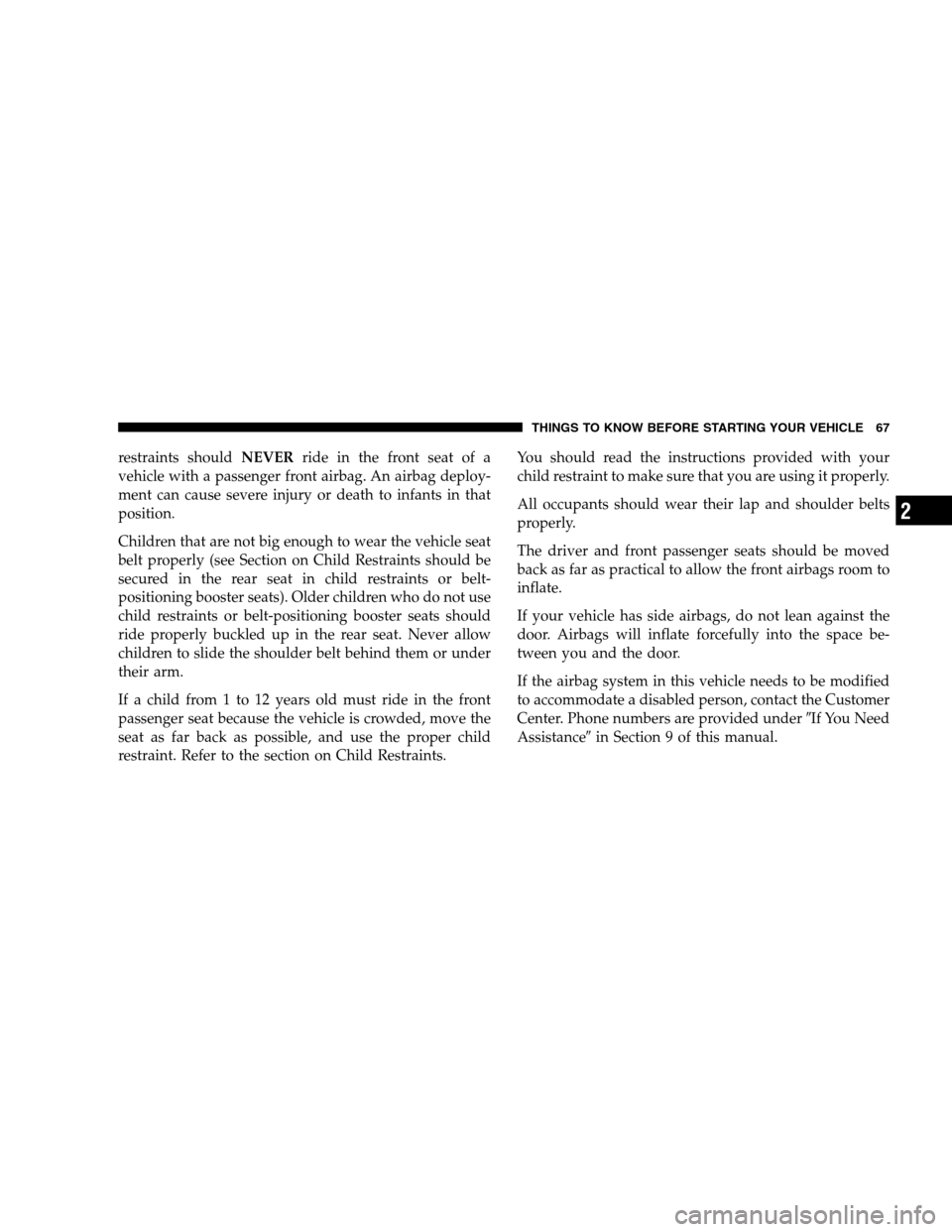
restraints shouldNEVERride in the front seat of a
vehicle with a passenger front airbag. An airbag deploy-
ment can cause severe injury or death to infants in that
position.
Children that are not big enough to wear the vehicle seat
belt properly (see Section on Child Restraints should be
secured in the rear seat in child restraints or belt-
positioning booster seats). Older children who do not use
child restraints or belt-positioning booster seats should
ride properly buckled up in the rear seat. Never allow
children to slide the shoulder belt behind them or under
their arm.
If a child from 1 to 12 years old must ride in the front
passenger seat because the vehicle is crowded, move the
seat as far back as possible, and use the proper child
restraint. Refer to the section on Child Restraints. You should read the instructions provided with your
child restraint to make sure that you are using it properly.
All occupants should wear their lap and shoulder belts
properly.
The driver and front passenger seats should be moved
back as far as practical to allow the front airbags room to
inflate.
If your vehicle has side airbags, do not lean against the
door. Airbags will inflate forcefully into the space be-
tween you and the door.
If the airbag system in this vehicle needs to be modified
to accommodate a disabled person, contact the Customer
Center. Phone numbers are provided under
9If You Need
Assistance9 in Section 9 of this manual.
THINGS TO KNOW BEFORE STARTING YOUR VEHICLE 67 2
Page 70 of 535
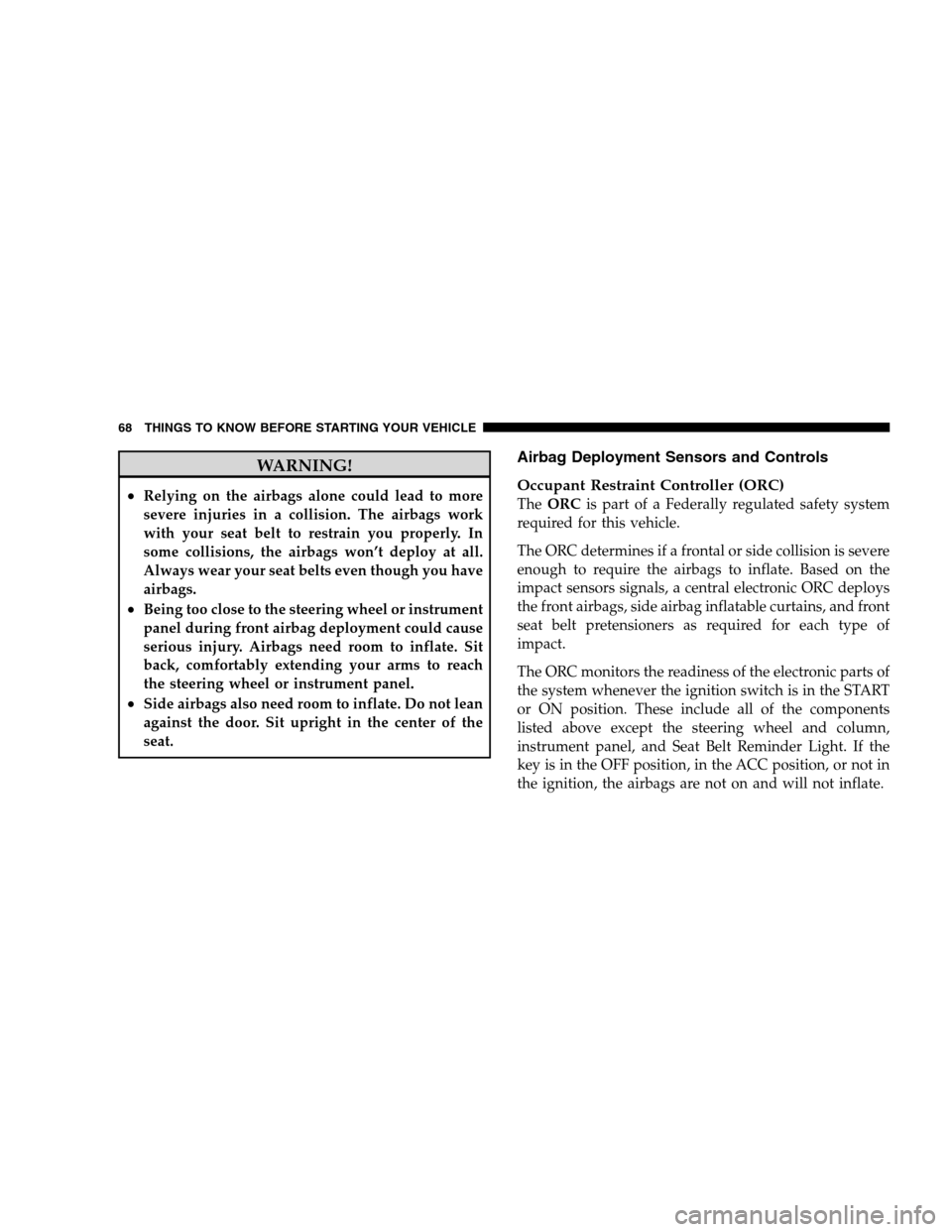
WARNING!
Relying on the airbags alone could lead to more
severe injuries in a collision. The airbags work
with your seat belt to restrain you properly. In
some collisions, the airbags won’t deploy at all.
Always wear your seat belts even though you have
airbags.
Being too close to the steering wheel or instrument
panel during front airbag deployment could cause
serious injury. Airbags need room to inflate. Sit
back, comfortably extending your arms to reach
the steering wheel or instrument panel.
Side airbags also need room to inflate. Do not lean
against the door. Sit upright in the center of the
seat.
Airbag Deployment Sensors and Controls
Occupant Restraint Controller (ORC)
The ORC is part of a Federally regulated safety system
required for this vehicle.
The ORC determines if a frontal or side collision is severe
enough to require the airbags to inflate. Based on the
impact sensors signals, a central electronic ORC deploys
the front airbags, side airbag inflatable curtains, and front
seat belt pretensioners as required for each type of
impact.
The ORC monitors the readiness of the electronic parts of
the system whenever the ignition switch is in the START
or ON position. These include all of the components
listed above except the steering wheel and column,
instrument panel, and Seat Belt Reminder Light. If the
key is in the OFF position, in the ACC position, or not in
the ignition, the airbags are not on and will not inflate.
68 THINGS TO KNOW BEFORE STARTING YOUR VEHICLE